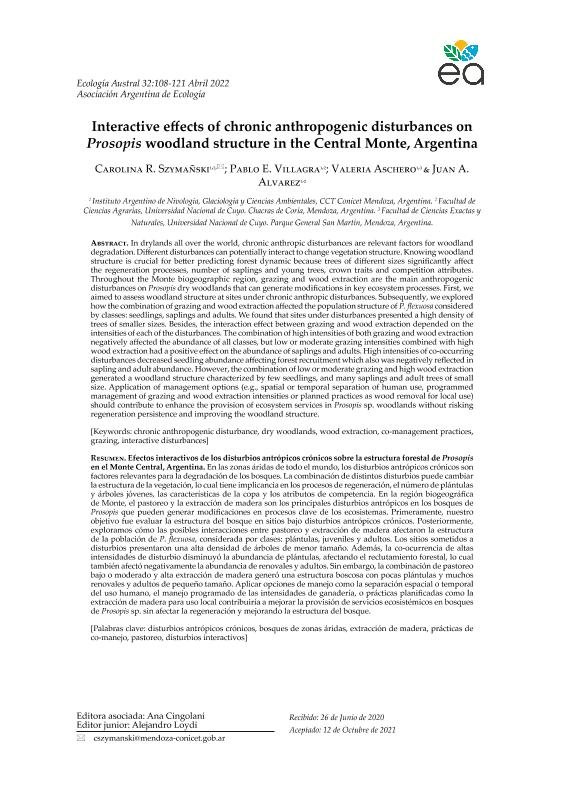Artículo
In drylands all over the world, chronic anthropic disturbances are relevant factors for woodland degradation. Different disturbances can potentially interact to change vegetation structure. Knowing woodland structure is crucial for better predicting forest dynamic because trees of different sizes significantly affect the regeneration processes, number of saplings and young trees, crown traits and competition attributes. Throughout the Monte biogeographic region, grazing and wood extraction are the main anthropogenic disturbances on Prosopis dry woodlands that can generate modifications in key ecosystem processes. First, we aimed to assess woodland structure at sites under chronic anthropic disturbances. Subsequently, we explored how the combination of grazing and wood extraction affected the population structure of P. flexuosa considered by classes: Seedlings, saplings and adults. We found that sites under disturbances presented a high density of trees of smaller sizes. Besides, the interaction effect between grazing and wood extraction depended on the intensities of each of the disturbances. The combination of high intensities of both grazing and wood extraction negatively affected the abundance of all classes, but low or moderate grazing intensities combined with high wood extraction had a positive effect on the abundance of saplings and adults. High intensities of co-occurring disturbances decreased seedling abundance affecting forest recruitment which also was negatively reflected in sapling and adult abundance. However, the combination of low or moderate grazing and high wood extraction generated a woodland structure characterized by few seedlings, and many saplings and adult trees of small size. Application of management options (e.g., spatial or temporal separation of human use, programmed management of grazing and wood extraction intensities or planned practices as wood removal for local use) should contribute to enhance the provision of ecosystem services in Prosopis sp. woodlands without risking regeneration persistence and improving the woodland structure. En las zonas áridas de todo el mundo, los disturbios antrópicos crónicos son factores relevantes para la degradación de los bosques. La combinación de distintos disturbios puede cambiar la estructura de la vegetación, lo cual tiene implicancia en los procesos de regeneración, el número de plántulas y árboles jóvenes, las características de la copa y los atributos de competencia. En la región biogeográfica de Monte, el pastoreo y la extracción de madera son los principales disturbios antrópicos en los bosques de Prosopis que pueden generar modificaciones en procesos clave de los ecosistemas. Primeramente, nuestro objetivo fue evaluar la estructura del bosque en sitios bajo disturbios antrópicos crónicos. Posteriormente, exploramos cómo las posibles interacciones entre pastoreo y extracción de madera afectaron la estructura de la población de P. flexuosa, considerada por clases: plántulas, juveniles y adultos. Los sitios sometidos a disturbios presentaron una alta densidad de árboles de menor tamaño. Además, la co-ocurrencia de altas intensidades de disturbio disminuyó la abundancia de plántulas, afectando el reclutamiento forestal, lo cual también afectó negativamente la abundancia de renovales y adultos. Sin embargo, la combinación de pastoreo bajo o moderado y alta extracción de madera generó una estructura boscosa con pocas plántulas y muchos renovales y adultos de pequeño tamaño. Aplicar opciones de manejo como la separación espacial o temporal del uso humano, el manejo programado de las intensidades de ganadería, o prácticas planificadas como la extracción de madera para uso local contribuiría a mejorar la provisión de servicios ecosistémicos en bosques de Prosopis sp. sin afectar la regeneración y mejorando la estructura del bosque.
Interactive effects of chronic anthropogenic disturbances on Prosopis woodland structure in the Central Monte, Argentina
Título:
Efectos interactivos de los disturbios antrópicos crónicos sobre la estructura forestal de Prosopis en el Monte Central, Argentina
Fecha de publicación:
04/2022
Editorial:
Asociación Argentina de Ecología
Revista:
Ecología Austral
ISSN:
0327-5477
Idioma:
Español
Tipo de recurso:
Artículo publicado
Clasificación temática:
Resumen
Archivos asociados
Licencia
Identificadores
Colecciones
Articulos(IANIGLA)
Articulos de INST. ARG. DE NIVOLOGIA, GLACIOLOGIA Y CS. AMBIENT
Articulos de INST. ARG. DE NIVOLOGIA, GLACIOLOGIA Y CS. AMBIENT
Citación
Szymañski, Carolina; Villagra, Pablo Eugenio; Aschero, Valeria; Alvarez, Juan Agustin; Interactive effects of chronic anthropogenic disturbances on Prosopis woodland structure in the Central Monte, Argentina; Asociación Argentina de Ecología; Ecología Austral; 32; 1; 4-2022; 108-121
Compartir
Altmétricas




